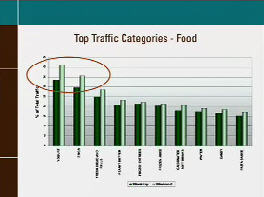Everyone involved in technology and marketing has had this conversation: They’re in a social setting, and the subject comes up about how technology is crafting messages to match consumer behavior. Someone pipes in, “Oh, like in Minority Report? That’s so wrong!” Although Gmail’s ads are customized based on the content of email messages, I’ve noticed that few object to that practice. Instead, they’ll complain about the ads appearing in Facebook — ads that clearly are using information users have given the network about themselves.
 It’s a Catch 22 for online marketers. In order to boost response rates, we need to know more about the people viewing our ads. This work of behavioral targeting sounds like a win/win: “We’ll only provide you with the ads that you will likely care about.” But in practice, consumers get spooked.I’m reminded of direct response research done years ago. It was a survey to find out how people like to be hit up for contributions to non-profit causes.
It’s a Catch 22 for online marketers. In order to boost response rates, we need to know more about the people viewing our ads. This work of behavioral targeting sounds like a win/win: “We’ll only provide you with the ads that you will likely care about.” But in practice, consumers get spooked.I’m reminded of direct response research done years ago. It was a survey to find out how people like to be hit up for contributions to non-profit causes.
Here’s how consumers responded:
- Least favorite: Personal asks
- 2nd Least: Telemarketing calls
- 3rd Least: Direct mail
What researchers at the time found telling was the direct correlation that existed between disliking a method of asking for donations and its effectiveness in getting them. In other words, personal asks — your sister-in-law selling Girl Scout cookies for her daughter — are most effective in terms of closing rates. The closing rates of telemarketing (back when this was a more viable medium for fund raising) were nearly as good. And a distant third in terms of effectiveness was direct mail.
So what’s really going on here? The accepted theory is this: We all have limited money to contribute to causes, and we would prefer to put off making decisions about where that money should go. Therefore, the most effective ways of forcing a decision are the least preferred.
Similarly, we love DVRs, because they allow us to zoom past commercials. They give us a way to avoid participating in commerce. They can’t touch us because we’re averting our eyes.
Behavioral targeting, if done properly, presents ads that also touch us. Thus, we look for reasons to hate the practice. Privacy is as good a reason as any and better than most!
So what’s the solution?
I do think that attitudes are slowly changing, and this change will eliminate privacy concerns as a reason to hate behavioral targeting.
Here’s an example. Consumers using social media are getting more comfortable with the various personas that they present on networks. They’ll show their “all-business” persona on LinkedIn, and their more casual facade on Facebook. Both are true depictions of the user, but they’re single facets of a full personality. Context determines how consumers behave on these sites. They are becoming accustomed to being watched by friends and business associates.
Reading Online Body Language
These same consumers are seeing how they can watch their friends right back. They are learning to “read” a friend’s feelings and preferences, based on online behavior. Consumers are getting accustomed to the online equivalent of body language. Or maybe that’s too strong a word. We’re all quite conscious of what we’re conveying, and body language implies unconscious action. Maybe what we’re doing on social media is more akin to a Kabuki dance.
Reading these dances is what marketers behind behavioral targeting are learning at a mass level, and turning into surprisingly accurate algorithms. But when it’s done by machines, in the service of a sale, many consumers still insist it’s “so wrong.”
Perhaps not forever.
To predict how people will react in the future — especially in areas such as privacy — I try to look at real world analogies. It’s not hard to imagine a web site as similar to a retail store. A while ago I wrote about how stores are analyzing shoppers using arrays of cameras. One system, called PRISM, is finding some unexpected insights into shopper preferences and behaviors. Shoppers aren’t getting freaked out. The prime reason: Most are oblivious to the surveillance.
But what if the people behind the cameras sprung up from their chairs and raced into the aisles, to say things like, “I saw you were looking at those lawn rakes. Can we interest you in some yard waste trash bags as well?” There would probably be lost sales, at the very least!
In the online world there are intercepts like this, but they are automated. This automated “intercept” is something people will become more accustomed to over time, as a generation weaned on social media, and used to their online movements being watched, comes into the majority. They will be able to understand that their behavior is being measured by machines as well as their online friends. They’ll realize there is no man behind the online ad “curtain” … just a predictive model.
Blurring The Lens To Reduce The Creep Factor
Another trend that will help the acceptance of behavioral targeting is a move toward more explicit boundaries. For instance, I expect an eventual backlash to camera surveillance such as PRISM. But before this reaction can take hold, the boundaries of store monitoring will likely improve. This improvement in technology will, for once, be toward discreetly blurring the “analytical lens” — instead of making it sharper.
Radio tomographic imaging is a new way to study store traffic. It uses arrays of extremely inexpensive radio transmitters and receivers, placed around buildings, to display people moving within. Below is a demonstration of the technology.
The benefits of this technology over cameras, at least to marketers, is cost — both in equipment and the labor of monitoring. Because people become moving “blobs” of color, it’s easier for computers to analyze traffic patterns and behaviors. Less can sometimes be more. Combine this information with RFID signals and you have a way to track a shopping basket all the way to check-out.
Imagine how this could be used:
Before he leaves that store, a consumer might someday pass an “intelligent end cap.” This smart store display knows — based on radio tomographic imagery, enhanced by RFID data sent to it — when to light up. The end cap would know the consumer has a yard rake, and offers him the trash bags he forgot to add to his list.
This hypothetical consumer will probably be grateful, since he really did need the bags for his yard project. And after all, he was just a blob of color moving through the store.
Ironically, this is the level of detail being used for most online behavioral targeting. This is the “privacy invasion” that is causing such a fuss on Facebook and elsewhere.
Over time, consumers will become more comfortable with behavioral targeting’s perceived betrayal of privacy.
That will leave only one valid objection the technique: They just don’t want to buy more stuff.
 As you can imagine, the potential for improving the in-store experience is huge. Just as web marketers have walked away with significant improvements to their sites through web analytics, these marketers are nearly giddy with new-found knowledge. At least, that’s the impression I’ve received by press accounts of PRISM.
As you can imagine, the potential for improving the in-store experience is huge. Just as web marketers have walked away with significant improvements to their sites through web analytics, these marketers are nearly giddy with new-found knowledge. At least, that’s the impression I’ve received by press accounts of PRISM.